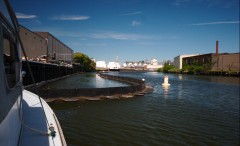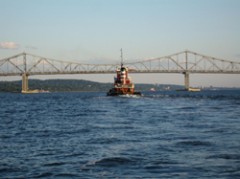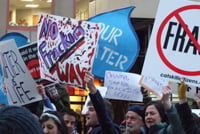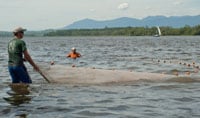Riverkeeper’s 11 Biggest Wins in 2011

View more images on our Flickr site
This past year, Riverkeeper and local advocates collectively rolled up our sleeves to fight extraordinary new threats to the Hudson River and our drinking water supplies. We saw the terrible tragedy of Fukushima unfold, reminding us why we must close Indian Point. Disastrous reports of damage caused by fracking around the country highlighted the need to stop New York from its headlong rush to authorize this unproven and dangerous process. An unprecedented fire and massive raw sewage discharge at New York City’s North River treatment plant brought home the damage to water quality caused by such spills each year. Here are Riverkeeper’s top eleven wins for ‘11:
Prevented New York from fracking with our water
Through public education, lobbying, lawsuits and community action, Riverkeeper has helped a growing coalition speak out against the New York Department of Environmental Conservation’s significantly deficient fracking proposal that threatens to endanger our pristine water and quality of life for millions of New Yorkers. A Riverkeeper lawsuit challenged the Delaware River Basin Commission’s (DRBC) flawed draft regulations that would have permitted fracking in a large swath of New York, New Jersey, Delaware and Pennsylvania. In November, DRBC suspended the vote on these regulations indefinitely. And Riverkeeper helped New York pass the first-ever legislation governing large-scale water withdrawals, which will require drillers to obtain permits for water withdrawals of the volume needed to frack for natural gas in the Marcellus Shale.
Waged a historic battle to close the Indian Point nuclear power plant
Riverkeeper is leading the legal challenge to Entergy’s pitch to keep its dangerous nuclear power plant operating for 20 years past its expected lifetime. This past October, we released an authoritative report with Natural Resources Defense Council, showing New York doesn’t need Indian Point’s power. In state hearings, Riverkeeper is arguing that radioactive leaks and the slaughter of a billion fish and other aquatic life annually put Indian Point out of compliance with the water quality permit it needs to continue operating. Riverkeeper is also preparing to present its case against Entergy in Nuclear Regulatory Commission relicensing hearings that will be historic for their scope and complexity. Following the tragedy at Fukushima Daiichi in Japan, we alerted the public about the risks involved in keeping the plant open and turned out a record number of people at the NRC public meeting in June. At the federal level, Riverkeeper continued its decades-long effort to enforce Section 316(b) of the Clean Water Act, which requires the use of the best technology available to reduce environmental impacts from water use at industrial plants like Indian Point.
Set up a line of defense for the public against sewage pollution in the Hudson and its tributaries
Riverkeeper successfully completed another water quality sampling season throughout the entire Estuary and continued to build partnerships with “citizen scientists” to sample tributary watersheds. Riverkeeper published the landmark How’s the Water? report showing that more than 20% of water samples collected by the Riverkeeper patrol boat over five years were unsafe for swimming because of sewage contamination, according to Environmental Protection Agency guidelines. Riverkeeper continued its testing and public notification efforts, becoming the first responders and bringing public attention to sewage releases in Manhattan, Ossining and Beacon. Riverkeeper launched a campaign to pass a Sewage Right to Know law in New York State that has been gaining attention and support including a hearing called by the state Senate Environmental Conservation Committee this fall. Meanwhile, we successfully pushed New York City to include green infrastructure in its plans to reduce sewage overflows during rain storms, and we are pushing the Capitol District to clean up longstanding sewage leaks as Governor Cuomo proposed a billion dollar infrastructure fund. Attention is finally being paid to this signature Riverkeeper issue.
Improved watershed management to protect upstate residents
Under pressure from Riverkeeper, the New York City Department of Environmental Protection and the New York State Department of Environmental Conservation began to address chronic discharges from the Ashokan Reservoir that have made the Lower Esopus Creek so muddy that this renowned trout stream is at risk. In 2011, Riverkeeper’s efforts, in collaboration with other stakeholders, led both to the first clean-water releases that benefitted downstream communities in Ulster County and to state and city commitments to improve regulation of muddy discharges after a thorough and public study of environmental impacts and alternatives. In Wawarsing, where aqueduct leaks have plagued residents, Riverkeeper pressured New York City to purchase the homes of affected residents, at a cost of $3.7 million.
Fought for a PCB cleanup that is ahead of schedule
General Electric Co., which for decades argued that dredging its legacy of toxic pollution from the upper Hudson would stir up massive amounts of PCBs, will enter 2012 with the goal of removing 25% more PCB-laden sediment than in 2011. The Environmental Protection Agency set the goal because so little contamination is being stirred up. In five years, the historic cleanup is scheduled for completion; a river where fish are no longer contaminated with PCBs is that much closer to becoming reality once again.

Photo Credit: Shara Shisheboran
Worked to restore Brooklyn’s polluted waterways
Riverkeeper marked major victories in its efforts to clean up the Gowanus Canal and Newtown Creek in Brooklyn in 2011. On Newtown Creek, the EPA ordered a Superfund cleanup that Riverkeeper has fought for since 2009, and which is expected to cost the polluters hundreds of millions of dollars and take two decades to complete. On the Gowanus Canal, MCIZ and related corporations were fined more than $482,000, following Riverkeeper patrols that documented evidence of years of pollution violations on the canal. Ongoing patrols, conducted in conjunction with environmental law enforcement officers, have resulted in a number of ongoing investigations and pollution cleanups on both waterways, making it possible for neighborhoods to reclaim their waterfronts.
Forced a polluter to help restore the fish population it hurt
When Riverkeeper successfully brought Mirant to justice for violating water quality laws at its now-defunct Lovett power plant in Rockland County, the state agreed to use the $115,000 fine to help the victims in the case: The fish. The settlement money is paying for a two-year study by SUNY researchers of American shad to help increase spawning productivity. Shad endured as the river’s most storied commercial fishery until it was closed in 2009 due to stock depletion.
Preserved public access to the Hudson in Poughkeepsie
When city leaders sold the use of Poughkeepsie’s riverfront dock for a song to a private tour boat company, Riverkeeper stepped in to preserve the people’s right to access the Hudson River at Waryas Park.

Spoke out against a Tappan Zee Bridge replacement boondoggle
Transportation authorities are trying to jam through the region’s biggest infrastructure project in a generation without adequately considering public transportation and traffic, or the project’s impact on the river or the climate, and without adequately including the public in its decision-making process. Riverkeeper is fighting to protect the environment, and the public’s right to participate.
Protected a vast swath of watershed wilderness
When New York purchased 1,200-acres of forests in New York City’s watershed on Belleayre Mountain, Riverkeeper and its partners claimed victory in their long-running campaign to preserve the land that naturally filters the water supply for 9 million New York City and Hudson Valley residents.
Restored the Newburgh waterfront for Newburgh residents
For years, Riverkeeper has pressured the Environmental Protection Agency to clean up the remnants of a scrap metal processor on the Newburgh waterfront that had become a toxic playground for neighborhood kids. Robert F. Kennedy, Jr. began the campaign in 1984 and it was championed by Riverkeeper watchdog Susan Cleaver. In 2011, the Superfund cleanup of the Consolidated Iron & Metal site was finally completed. Now a key piece of real estate on the Hudson River is safe and poised to be reborn as a community asset.
View Riverkeeper’s Top 2011 Accomplishments in a larger map



